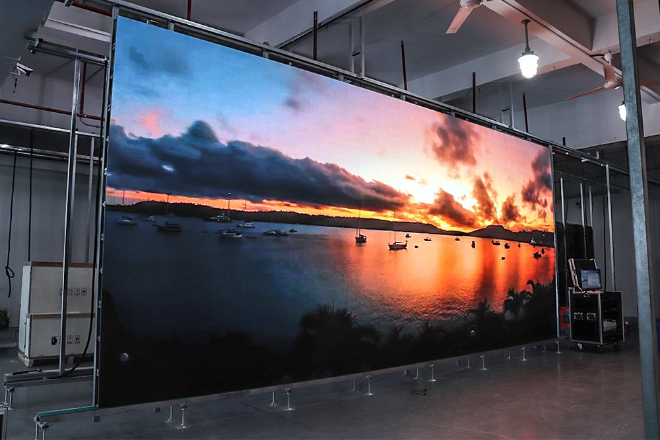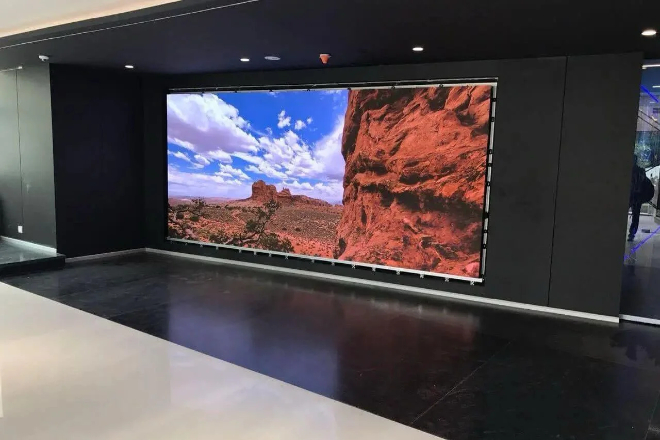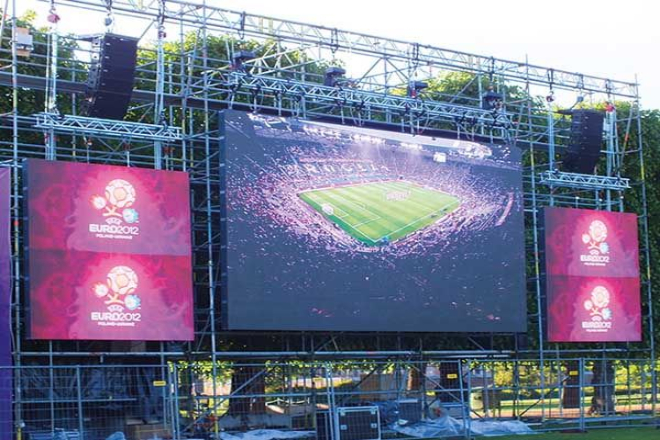Introduction

Have you ever encountered this situation: a good LED display suddenly flickers, has a distorted screen, or the colors become messy?
In fact, this is likely to be electromagnetic interference. Although the LED display looks powerful, it is actually very “delicate” and can be easily affected by the surrounding electromagnetic field. So, how to avoid this?
Table of Contents
1. What is electromagnetic interference of LED display
1). Causes of electromagnetic interference in LED display screens
The power cord is like a pipeline that “feeds electricity” to the display, but this pipeline will generate some “invisible magnetic fields” when it delivers electricity.
If the power cord is not placed properly, such as being too close to the signal line, these magnetic fields will “visit” and interfere with the signal in the signal line, just like someone making noise next to it, making the normal sound unclear.
The signal line is a “path” for transmitting the control signal of the display, but this path is easily interfered by the “bad guys” around.
For example, if the signal line is close to other electrical appliances (such as high-power motors, transformers, etc.), the electromagnetic fields generated by these appliances will “run” over and mix with the signals in the signal line, causing the signal to “change”.
There are many small components inside the LED display screen, such as driver chips, switching power supplies, etc. When these components are working, they will also generate some “electromagnetic garbage”.
If these “garbage” are not handled properly, they will “run around” inside the display screen and interfere with the normal operation of other components.
2). The impact of electromagnetic interference
- Flickering:
The display screen should display the picture steadily, but electromagnetic interference will make it “cramp”, sometimes bright and sometimes dark, just like a light bulb flashing.
- Speckled:
Under normal circumstances, the pixels of the display screen should be arranged neatly, but interference will make some pixels “disordered” and appear light that should not be there, just like “acne” on the screen.
- Color cast:
The color display of the display screen will become “deviated”, for example, the original red may be orange or purple, just like the colors on the palette are messed up.
Electromagnetic interference will put a lot of pressure on the components inside the display screen. Over time, the components will be “tired”.
For example, the switching power supply may frequently “go on strike” due to interference, resulting in a shortened life of the display screen.
The content displayed on the display screen is transmitted by data signals, but if the signal is interfered with, the data will be “transmitted incorrectly”.
For example, the text displayed on the screen may have one more or one less word, and the image may be misplaced, just like a courier delivered to the wrong place.
In short, electromagnetic interference is like an “invisible troublemaker” that will cause various problems on the LED display screen and affect normal use.
2. How do you design the power cord wiring to avoid LED screen interference?

1). Separate the power cord from the signal cord
The power cord and the signal cord are like two “neighbors” with completely different personalities.
The power cord is “loud” and generates an electromagnetic field when transmitting current, while the signal cord is “timid”, and the transmitted signal is very weak and easily interfered with.
If they are too close, the signal cord will be “harassed” by the electromagnetic field of the power cord, resulting in signal distortion.
1.1). Separate the wiring and keep enough distance
When wiring, be sure to separate the power line and the signal line. Just like dividing the motor vehicle lane and non-motor vehicle lane on the road, let them not interfere with each other.
Generally speaking, the distance between the power line and the signal line should be kept at least 10 cm. If conditions permit, the farther the distance, the better.
For example, at the installation site of some large LED display screens, the power line and the signal line can be routed in different bridges or pipes, which can minimize the electromagnetic coupling between them.
1.2). Keep the power line away from sensitive signal lines
In the layout, pay special attention to the direction of the power line. Try to keep the power line away from those particularly sensitive signal lines, such as those that transmit high-definition video signals or control signals.
These signal lines are like “fragile items” and need special protection. If the power line has to cross the signal line, it is best to cross them at a 90-degree angle, because this can minimize electromagnetic interference.
2). Thicken the power line and use low-impedance materials
The power line is like a “highway,” and the current is the “traffic”. If the current is large but the power line is too thin, it will cause “traffic jams”, increase resistance, and generate more electromagnetic interference.
The right power line width and low-impedance materials can effectively reduce these problems.
2.1). Choose the right power line width
Choose a power line of appropriate width according to the power and current of the LED display. If the current is large, the cross-sectional area of the power line should also be increased accordingly.
For example, for a high-power LED display, you may need to use a power line with a cross-sectional area of 4 square millimeters or even larger.
This can reduce the loop resistance and reduce the loss and electromagnetic interference of the current during transmission.
Imagine that if you use a very thin water pipe to transport a large amount of water, the water pressure will be very high and the water flow will be very unstable; but if you use a thick water pipe, the water flow will be more stable.
2.2). Use low impedance materials
The material of the power line is also very important. Low impedance materials are like a “super highway” that allows the current to pass more smoothly and reduce electromagnetic interference.
For example, copper wire is better than aluminum wire because copper has lower resistance and stronger anti-interference ability. Although the cost of copper wire is higher than that of aluminum wire, copper wire is a better choice in terms of long-term use and stability.
In addition, the insulation layer of the power cord is also very important. Good quality insulation materials should be selected to prevent leakage and electromagnetic leakage.
3). Use shielded power cord
For power cords that need to be transmitted over long distances or are easily interfered with, shielded cables are a very effective method.
3.1). Use shielded cables
Shielded cables are like putting a layer of “protective clothing” on the power cord, which can effectively block external electromagnetic field interference.
The shielding layer of the shielded cable is usually composed of a metal braided mesh or metal foil, which can reflect and absorb external electromagnetic waves.
For example, in some complex industrial environments, there may be many strong electromagnetic devices around, such as large motors, transformers, etc.
The electromagnetic fields generated by these devices can easily interfere with the power cord. Shielded cables can protect the current inside the power cord and reduce interference.
3.2). Good grounding
The shielding layer of the shielded cable must be grounded, and the grounding must be good.
Grounding is like providing a “flood discharge port” for the shielding layer, allowing the interference current to be smoothly introduced into the earth rather than staying in the shielding layer to continue to “make trouble”.
If the grounding is poor, the shielding layer will not work effectively and may even become a “source of interference”. When grounding, make sure that the resistance of the grounding wire is small enough and that the grounding terminal is firmly connected to the grounding system.
Generally speaking, the grounding resistance should be less than 4 ohms to ensure a good grounding effect.
4). Reasonable design of the power grounding system
The grounding system is like a “safety net” that can smoothly conduct interference current into the earth.
If the grounding system is not good, the interference current has nowhere to go and will “run around” around the power line, causing more electromagnetic interference.
4.1). Establish a complete grounding system
The power grounding system should be designed reasonably to ensure that the grounding wire has sufficient cross-sectional area and the grounding terminal is firmly connected.
It is best to use copper wire for the grounding wire, and it should be as short and straight as possible to reduce the grounding resistance.
At the installation site of the large LED display, a special grounding pile can be set up to connect all the grounding wires to the grounding pile, and then the interference current is conducted into the earth through the grounding pile.
The grounding pile should be buried deep enough underground, generally at least 1 meter deep, to ensure a good grounding effect.
4.2). Avoid poor grounding
The grounding resistance should not be too large, and the grounding should be firm. If the grounding resistance is too large or the grounding wire is in poor contact, it will be difficult for the interference current to be introduced into the earth, which will increase the electromagnetic interference.
For example, in some humid environments, the grounding terminal is prone to rust, resulting in poor grounding. Therefore, it is necessary to regularly check the connection of the grounding system, clean the rust in time, and ensure that the grounding system is always in good working condition.
Through the above methods, the electromagnetic interference of the power cord to the LED display can be effectively reduced.
In simple terms, it is necessary to separate the power cord and the signal cord, protect the power cord with appropriate materials and shielding measures, and ensure that the grounding system is good.
In this way, the LED display can work more steadily, and the display effect will be better.
3. How do you design the signal line wiring to avoid LED screen interference?
The signal line is the “nerve” of the LED display, responsible for transmitting control signals and data signals.
If the signal line is interfered with, the display will have various problems, such as flickering, flower screen or display of wrong content. In order to avoid these problems, the wiring design of the signal line is very important.
1). Choose a high-quality signal line
The quality of the signal line directly affects the anti-interference ability. Choosing a suitable signal line is the first step to avoid interference.
1.1). Choose signal cables with a good shielding effect
Shielded cables are like putting a layer of “protective clothing” on signal cables, which can effectively block external electromagnetic interference. Common shielded signal cables include twisted pair cables and coaxial cables.
Twisted pair cables can offset the interference of external magnetic fields by twisting two wires together; coaxial cables provide better shielding effects through the insulation layer between the inner and outer conductors.
For example, on occasions where high signal quality is required, such as high-definition video signal transmission, using coaxial cables is a better choice.
1.2). Ensure impedance matching of signal cables
Impedance matching is like making the signal “smooth all the way” during transmission.
If the impedance of the signal cable does not match the impedance of the transmitting and receiving ends, the signal will be reflected, resulting in signal distortion and interference.
In general, the impedance of the signal cable should be consistent with the input and output impedance of the device. For example, the common video signal cable impedance is 75 ohms, and the audio signal cable impedance is 110 ohms.
When wiring, choose signal cables that meet these impedance standards and ensure that the impedance of the connection is matched.
2). Optimize the signal line routing path
The signal line routing path is also very important. A reasonable routing path can reduce the interference of the signal.
2.1). Signal lines should be as straight as possible
During the transmission process of the signal line, bending and looping will cause inductive interference.
Try to make the signal line run in a straight line to reduce the number of bends and loop area.
If the signal line must be bent, the bending radius should be as large as possible to avoid sharp bends. For example, when wiring, you can use a cable trough or cable tube to fix the signal line to ensure that it runs in a regular direction.
2.2). Avoid parallel routing of signal lines and power lines
Signal lines and power lines are “enemies”. If they are parallel, the electromagnetic field generated by the power line can easily interfere with the signal line.
If parallel routing cannot be avoided, a cross layout can be used to allow the signal line and the power line to cross at a 90-degree angle, which can minimize electromagnetic coupling.
In addition, isolation measures can be added between the signal line and the power line, such as using shielding materials or adding partitions to the cable trough.
3). Strengthen signal line shielding and grounding
For signal lines that are susceptible to interference, strengthening shielding and grounding is the key.
3.1). Install the shielding layer and ensure good grounding
An additional shielding layer can be installed for important signal lines. The shielding layer is like an “electromagnetic shield” that can effectively block external electromagnetic interference.
The shielding layer must be grounded, and grounding is the key to the shielding effect.
A poorly grounded shielding layer not only fails to play a shielding role, but may also become a source of interference. When grounding, ensure that the grounding resistance is small enough, generally less than 4 ohms.
3.2). Install filters at the input and output ends of the signal line
The filter can filter out high-frequency interference components in the signal and further weaken the interference signal.
Installing filters at the input and output ends of the signal line is like setting up a “security gate” at the entrance and exit of the signal, allowing only clean signals to pass through.
For example, in some industrial environments, signal lines are easily affected by high-frequency electromagnetic interference, and installing filters can effectively improve signal quality.
4). Reasonable setting of signal amplifiers and isolators
Signals may attenuate during long-distance transmission. Reasonable setting of signal amplifiers and isolators can protect signal quality.
4.1). Reasonable setting of signal amplifiers
When the signal transmission distance is long, or the signal attenuation is large, the signal strength will become weak and susceptible to interference.
In this case, a signal amplifier can be reasonably set on the signal transmission path to enhance the signal strength.
The signal amplifier is like a “gas station” for the signal, replenishing energy for the signal so that it can continue to transmit stably.
For example, in a large LED display system, the signal transmission distance may reach tens of meters or even hundreds of meters. A reasonable setting of the signal amplifier can ensure that the signal is not distorted during transmission.
4.2). Use signal isolators
The signal isolator can isolate interference signals and protect the normal operation of the LED display. It cuts off the propagation path of the interference signal by electrical isolation.
For example, in some complex electromagnetic environments, the signal isolator can effectively prevent external interference signals from entering the control system of the LED display and ensure the stable operation of the display.
The wiring design of the signal line is crucial to avoid electromagnetic interference in the LED display.
By selecting high-quality shielded signal lines, optimizing wiring paths, strengthening shielding and grounding, and reasonably setting signal amplifiers and isolators, the interference of the signal lines can be effectively reduced, ensuring stable and reliable signal transmission of the LED display.
4. If it has been interfered with, how to "cure" it?

1). Optimize the external environment
First, check the environment around the LED display screen and minimize possible interference sources.
If there are radio transmitters, high-frequency equipment or other strong electromagnetic radiation sources near the display screen, consider removing them or taking shielding measures.
For example, avoid installing the display screen in areas close to high-voltage transmission lines or large motors. In addition, installing lightning protection facilities is also a very important step.
Lightning activities may bring strong electromagnetic pulses, causing interference or even damage to the display screen.
Installing lightning rods, lightning protection nets and other facilities on or near the bracket of the display screen can effectively guide lightning currents and protect the display screen from lightning interference.
At the same time, check whether the installation position of the display screen is reasonable.
If the display screen is close to the interference source, consider re-adjusting the installation position to increase the distance from the interference source, thereby reducing the impact of electromagnetic interference.
2). Check and optimize the signal line
The signal line is a key part of the LED display screen to transmit control signals. If the signal line is interfered with, the display effect of the display screen will be greatly reduced.
First, check whether the existing signal line is a high-quality shielded line, such as a twisted pair or coaxial cable.
These shielded cables can effectively block interference from external electromagnetic fields.
If the signal cable is found to be of poor quality, it should be immediately replaced with a cable with better shielding performance. Secondly, recheck the wiring path of the signal cable.
The signal cable should be as straight as possible, and the area of bends and loops should be reduced because bends and loops will increase the chance of inductive interference.
At the same time, avoid parallel routing of signal cables and power cables because power cables will generate electromagnetic fields when transmitting current, which can easily interfere with signal cables.
If parallel routing cannot be avoided, the signal cable and power cable should be crossed at a 90-degree angle as much as possible, or isolation measures should be added between the two, such as using shielding materials or adding partitions to the cable trough.
In addition, check whether the shielding layer of the signal cable is well grounded. Grounding is the key to the shielding effect.
A poorly grounded shielding layer not only cannot play a shielding role but may also become a source of interference.
Make sure that the grounding resistance of the shielding layer is small enough, generally less than 4 ohms, to ensure a good grounding effect.
3). Adjust device parameters
Improper settings of device parameters, such as the receiving card of the LED display, may also cause display abnormalities.
Check whether the parameter settings of the receiving card are reasonable, appropriately reduce the clock frequency (such as DLCK), and adjust the phase and duty cycle.
Adjustment of these parameters can help reduce interference during signal transmission and improve signal stability and accuracy.
In addition, you can also put an anti-interference magnetic ring (absorption magnetic ring) on the signal line or power line.
This magnetic ring can effectively suppress high-frequency noise and reduce the impact of electromagnetic interference on the signal.
The use of the anti-interference magnetic ring is very simple. Just put it on the signal line or power line, but be careful to choose a magnetic ring of the right size to ensure that it can fit the cable tightly.
4). Improve power quality
Power quality is crucial to the normal operation of the LED display. Providing a stable power supply to the display and adding a power filter or voltage stabilizer can effectively reduce power fluctuations and noise.
Power fluctuations and noise may cause flickering, uneven brightness, and other problems with the display.
The power filter can filter out high-frequency interference components in the power supply, while the voltage stabilizer can ensure the stability of the power supply voltage.
If there is an interference signal in the power supply, you can consider using a purified power supply or an online UPS power supply.
Purifying the power supply can effectively remove impurities and interference in the power supply, while the online UPS can not only provide a stable power supply but also has a certain anti-interference ability.
By improving the quality of the power supply, a more stable and clean working environment can be provided for the LED display, reducing the impact of electromagnetic interference.
5). Check the hardware connection
The reliability of the hardware connection is directly related to the display effect of the LED display. Check the connectors of the signal lines one by one to ensure that there are no short circuits, open circuits and other problems.
Short circuits or open circuits may cause signal transmission interruption or distortion, thereby affecting the display effect of the display.
At the same time, regularly check the power supply, control card, connection cables and other components of the display, and replace aging or damaged components in time.
Aging components may experience performance degradation or failure, causing electromagnetic interference problems.
For example, an aging power supply may generate more electromagnetic noise, and an aging connection cable may have problems such as poor contact.
By checking and replacing aging components, the occurrence of electromagnetic interference can be effectively reduced and the reliability of the display can be improved.
6). Use technical means
From a technical point of view, optimizing the signal transmission method can effectively reduce electromagnetic interference.
For example, differential signal transmission technology is used, which can effectively improve the reliability of data transmission and reduce signal interference during transmission.
Differential signal transmission offsets the influence of external interference by sending two signals of opposite phases and performing differential processing at the receiving end.
In addition, adding filters to the input and output ends of the signal line can further weaken the interference signal.
The filter can filter out the high-frequency interference components in the signal and only let the useful signal pass.
By adopting these technical means, the anti-interference ability of the signal can be effectively improved and the display effect of the LED display can be improved.
7). Adjust the display settings
The display settings of the LED display will also affect its display effect. Adjust the brightness and contrast of the display according to the actual environment to obtain better display effects.
If the ambient light is strong, the brightness can be appropriately increased; if the ambient light is dark, the brightness can be appropriately reduced to avoid the influence of too bright or too dark on the display effect.
At the same time, check whether the resolution and refresh rate of the display are set correctly. If the resolution or refresh rate is set improperly, it may cause blurry or flickering images.
Ensuring that the resolution and refresh rate of the display match the input signal can effectively reduce the occurrence of display problems.
8). Professional maintenance
If the above methods cannot solve the problem, it is recommended to contact professional LED display maintenance services.
Professional maintenance personnel have rich experience and professional equipment to conduct comprehensive inspections and diagnosis of the display.
They can quickly locate the problem and take effective measures to repair it.
5. Conclusion
Electromagnetic interference sounds terrible, but in fact, as long as we deal with it carefully, we can easily get it done. Separate wiring, choose good materials, shield and ground well.
These methods sound simple, but they really work! I hope these tips can help everyone and keep your LED display beautifully lit!
Finally, if you want to know more about LED displays, please get in touch with us.
